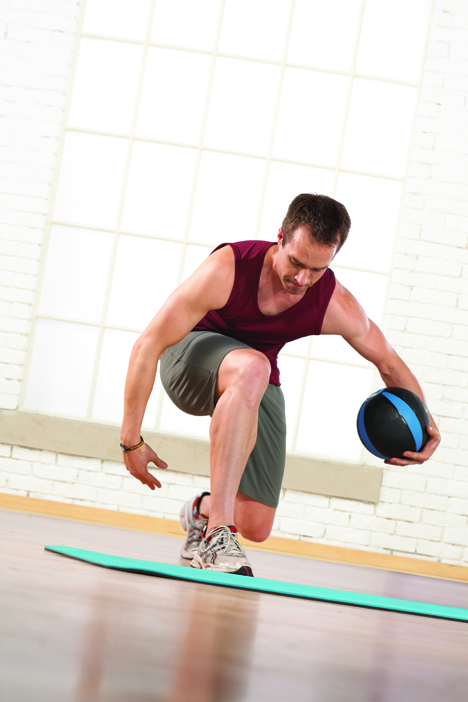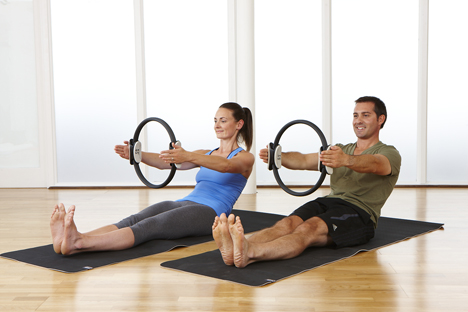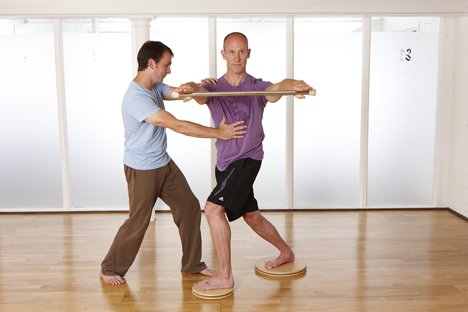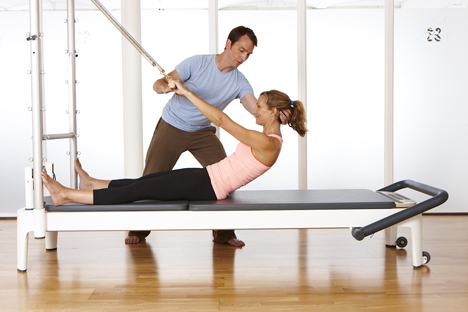|
Leisure Management - Pilates predictions

Pilates

|
|
| Pilates predictions
|

What’s the most exciting innovation in the world of pilates at the moment? Kath Hudson asks the experts for their thoughts
|

Functional training is fusing with pilates © Merrithew Corporation


Many mat and reformer classes now see a 50:50 split between men and women Photo: body control pilates


Pilates teachers are upgrading their qualifications to teach special populations Photo: body control pilates


Alongside reformer classes, there needs to be a standing element for bone health Photo: body control pilates
|
|
|
In recent years, pilates has had something of a soft image: an activity for yummy mummies or ladies who lunch. But this is changing. Many operators are making classes more challenging, with the addition of cardio and functional elements for example, which is capturing the attention of new audiences such as men and elite sports people. Pilates is also a great prehab and rehab tool, and a perfect antidote to lifestyles that involve far too many hours of sitting around plugged into technology. Little surprise, then, that the number of gyms offering pilates classes, as well as the number of dedicated studios, is growing – this according to James McCoy, research director at YouGov. So where is pilates headed next? Will we see new interpretations of the activity? Will clubs start hiring more male instructors? How will new equipment shape programmes? We ask the experts for their thoughts on the most exciting innovation in pilates at the moment…
|
|
 |

LYNNE ROBINSON
BODY CONTROL PILATES
FOUNDER AND DIRECTOR
 |
|
Pilates is losing its girly image. Ten years ago, the normal class ratio was 10 women to one man but, as more men appreciate the benefits of the discipline, it’s now a 50:50 split in many of our matwork and reformer classes. A growing number of men are also going on to teach pilates.
The fact that most Premier League football clubs now use pilates as part of their training helps create demand, as does the fact that our national cricket, rugby and rowing teams, top athletes including Mo Farah, and top tennis players including Novak Djokovic and Andy Murray all practise a version of pilates to help with performance enhancement and injury prevention.
Reformer classes give much more of a physical challenge. Exercises still focus on alignment, breathing and centering (core stability), but the pace is generally more dynamic and the challenges just that bit tougher. There’s less TLC, more vigorous encouragement and more use of props, such as foam rollers and toning circles, which add variety and challenge.
Most of Joseph Pilates’ earliest clients were army cadets and policemen in Germany and the UK. I wonder how long it will be before we come full circle and it’s the girls who are outnumbered?
|
|
 |

CHRIS ONSLOW
MANAGING DIRECTOR
MBODIES TRAINING ACADEMY
 |
|
We’re now seeing the professionalisation of pilates as it moves beyond the mainstream and into niche segments, such as special populations. Pilates has been a part of mainstream fitness in the UK for approximately 10 years now, and around 25 per cent of qualified pilates instructors have advanced their training to allow them to work effectively with niche segments of the market.
There’s both anecdotal and research-based evidence that pilates is beneficial to populations including Parkinson’s disease and Multiple Sclerosis patients, and for breast cancer rehabilitation. This is allowing pilates to move beyond being seen as purely a core strengthening, body-shaping fitness method. It’s now attracting a more long-term, wellness-orientated customer base that’s constantly being refreshed, allowing pilates instructors to specialise and differentiate themselves.
|
|
 |

JUSTIN ROGERS
CREATIVE DIRECTOR
TEN PILATES
 |
|
Transforming pilates into an all-encompassing workout is one of the current exciting trends, introducing elements from circuit and weight training, and even group cycling, to make the workout more intense, more cardiovascular and more functional. Adding elements from other disciplines in this way is making pilates more appealing and more relevant to more people. Males and professional sports people are now increasingly starting to see the benefits, for example – we’re working with a number of sports people, including the London Irish rugby squad.
Our programme still has the teachings of Joseph Pilates at its heart, but our brand of dynamic pilates focuses on results and time-efficiency – a full-body workout that enables people to see and feel the difference, fast.
Our in-house academy is also constantly looking to refresh our programming with new iterations of classic, proven exercises. For instance, we’re currently looking at what we can add by introducing jumpboards. But although we’re always looking at how we can refine our offering to meet client needs, we won’t introduce things just for the sake of bringing in something new – only if it is valid and beneficial.
|
|
 |

GLENN WITHERS
FOUNDING DIRECTOR
APPI HEALTH GROUP
 |
|
The future of pilates is getting off the mat, and we’re seeing a move towards more functional upright positions. In order for pilates to really make a significant difference in the rehabilitation world, we must demonstrate that the exercises can make people’s daily activities a lot better.
Just exercising on the mat, or reformer, will not have a direct correlation to upright functional movement patterns that cause most of our daily discomforts. When exercising in these positions, you’re working across gravity, not against gravity as we do when we’re standing upright. So although lying down is good for initial rehabilitation, it’s not enough for a full functional recovery.
We need a standing element to generate the bone-loading required to increase bone strength. With osteoporosis predicted to affect one in two women in the UK, and one in five men, this is very important – we must focus exercise on addressing bone health.
APPI has therefore developed a standing concept that includes a combination of pilates, gyrokinesis (rotational movements) and the Anatomy Trains concepts of functional fascial movements. In our body, we have a fascinating link of anatomical structures that all work in unison to create effective movement. When one understands these patterns, or connections, we can exercise in these directions to achieve a better outcome.
By moving into this functional, upright response, we’ve seen a drastic growth in the number of older people gaining benefits from pilates, including reduced falls – and with that, avoiding potentially life-changing hip and spinal fractures.
|
|
 |

KEN ENDELMAN
CEO
BALANCED BODY
 |
|
I think one of the most exciting things to happen in the pilates world is the advent of barre programmes. A barre is a stationary handrail, originally used during ballet warm-up exercises.
While pilates classes generally rely on a lot of equipment, barre classes only need a sturdy chair for each participant and the barre, which can be bought at a reasonable price and can accommodate six to eight participants. Classes are organised in a way that imitates interval training, so students have bursts of physical activity interspersed with deep stretching. Participants are encouraged to hold positions for longer than is usual in pilates classes, in order to create more muscle density and strength.
Now many pilates companies are creating high-energy barre programmes that include both a mind-body element and dynamic functional movement, making it a great marketing tool to attract and retain members.
|
|
 |
| Originally published in Health Club Management 2013 issue 8
|
|
 |
|